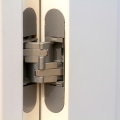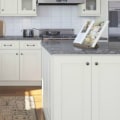In recent years, dark kitchens have emerged as a bold and stylish design trend in modern homes. With deep hues such as charcoal, navy, black, and dark wood finishes, these kitchens create a sense of luxury and drama that can transform any home. However, like any design choice, opting for a dark kitchen comes with its own set of advantages and disadvantages. Deciding whether this look is right for your home depends on factors like lighting, space, maintenance, and personal style. In this article, we’ll explore the pros and cons of dark kitchens to help you determine if this aesthetic is a good fit for your next kitchen renovations.
Pros of Dark Kitchens
1. Elegant and Sophisticated Aesthetic
One of the biggest appeals of dark kitchens is their ability to create a sense of elegance and sophistication. Dark colors add depth and richness to a space, making it feel more refined and luxurious. Black cabinets, deep blue countertops, or dark wood finishes give a kitchen an upscale look that is both timeless and contemporary. For homeowners who want to make a statement with their kitchen design, dark colors offer a striking alternative to the traditional light or neutral palettes.
Additionally, dark kitchens have a unique ability to highlight other design elements. The contrast of dark cabinetry with sleek metallic accents, marble countertops, or light-colored backsplashes can create a stunning visual effect. This combination of light and dark materials brings texture and interest to the space, elevating the overall design.
2. Camouflage for Imperfections
Another advantage of dark kitchens is that they tend to be more forgiving when it comes to hiding imperfections. Scratches, smudges, and stains are often less noticeable on dark surfaces compared to lighter ones. This can be particularly beneficial for families with children or high-traffic kitchens where surfaces are likely to experience wear and tear. Dark cabinetry, countertops, and floors are also better at concealing dust and dirt, making the kitchen appear cleaner for longer periods.
For homeowners who want to maintain a polished and well-kept look without constant cleaning, dark kitchens can provide a practical solution. While no kitchen is immune to the occasional mess, the ability of dark surfaces to disguise everyday imperfections can make upkeep feel less overwhelming.
3. Cozy and Intimate Ambiance
Dark kitchens can create a cozy and intimate atmosphere that’s ideal for homeowners who want their kitchen to feel like a welcoming retreat. The use of dark colors can make the space feel more grounded and comfortable, especially when combined with warm lighting and natural materials like wood and stone. This design choice is particularly effective in open-concept homes where the kitchen plays a central role in family gatherings and social events.
The darker tones in the kitchen can also help define the space and make it feel more distinct from other areas of the home. In open-plan layouts, dark kitchens can act as an anchor that provides a sense of separation without the need for physical barriers.
Cons of Dark Kitchens
1. Can Make the Space Feel Smaller
One of the most significant drawbacks of dark kitchens is that they can make a space feel smaller, especially in rooms with limited natural light. Dark colors tend to absorb light, which can create a sense of heaviness and make a room feel more enclosed. For homeowners with small or narrow kitchens, opting for a dark color palette may accentuate the compactness of the space rather than open it up.
If you’re working with a smaller kitchen, careful consideration of lighting is essential. Introducing plenty of natural light, adding task lighting, or incorporating reflective surfaces like glass and stainless steel can help balance the darkness and prevent the space from feeling too confined.
2. Requires Strategic Lighting
As mentioned, lighting is a crucial factor in making a dark kitchen work. While dark kitchens have the potential to look stunning, they can also become gloomy if not properly illuminated. Poor lighting can make the kitchen feel uninviting and difficult to work in, especially if you rely on artificial lighting during the day. Overhead lighting, under-cabinet lighting, and strategically placed pendant lights are essential to ensure the space feels bright and functional.
For homeowners who don’t have ample natural light in their kitchen, investing in a well-thought-out lighting plan is key to making a dark kitchen design successful. Without sufficient lighting, the beautiful details of dark cabinetry, countertops, and flooring may go unnoticed.
3. Shows Watermarks and Smudges
While dark kitchens do a great job of hiding dust and dirt, they can also highlight certain types of marks, such as water spots, fingerprints, and smudges, particularly on glossy or polished surfaces. Dark countertops made from materials like granite or quartz may require frequent wiping to maintain a spotless appearance, especially in areas around sinks and appliances. Matte finishes tend to minimize this issue, but they can still show oil and grease marks.
For homeowners who are meticulous about cleanliness, this could become an ongoing maintenance challenge. While dark kitchens may require less frequent cleaning for dust and dirt, they might demand more attention when it comes to keeping surfaces streak-free.
Conclusion
Dark kitchens offer a bold and sophisticated design choice that can elevate the overall aesthetic of a home. The luxurious appearance, ability to camouflage imperfections, and cozy ambiance make them an attractive option for homeowners seeking a stylish yet practical space. However, the potential downsides—such as making a space feel smaller, requiring careful lighting, and showing watermarks—are important factors to consider when planning your kitchen renovations. Ultimately, whether a dark kitchen is the right choice depends on your personal preferences, the size and layout of your kitchen, and your commitment to maintenance. By carefully weighing the pros and cons, you can create a kitchen that meets your design vision while remaining functional and inviting.


